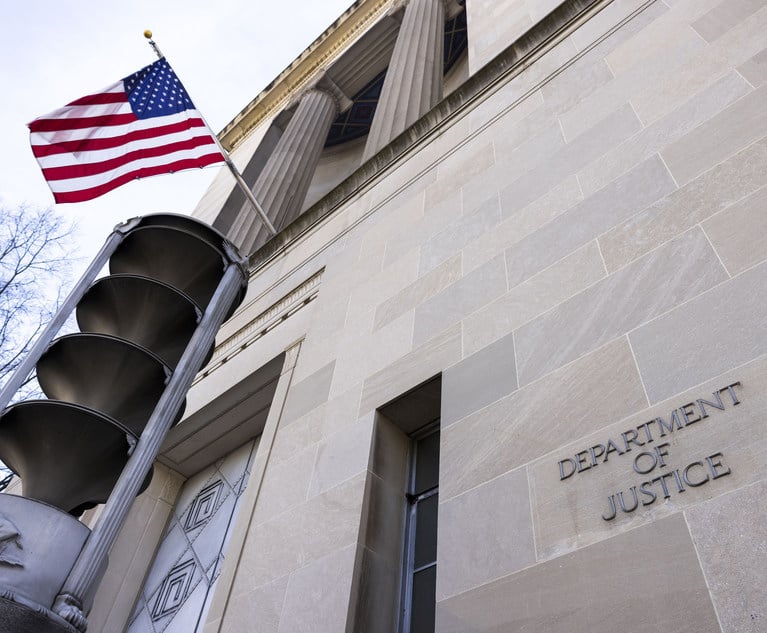 H. Christopher Boehning & Daniel J. Toal
H. Christopher Boehning & Daniel J. Toal'Flawed' Legal Hold Warrants Sanctions; New Commentary Provides Guidance
In their Federal E-Discovery column, H. Christopher Boehning and Daniel J. Toal discuss a recent case that provides an example of a party's “flawed” legal hold that led to a discovery sanction. A newly updated commentary from The Sedona Conference could potentially guide organizations in how to avoid such a situation.
February 04, 2019 at 02:50 PM
7 minute read
Determining how best to comply with a duty to preserve discoverable information can pose challenges for an organization. This is especially true if there is no pre-established set of procedures governing when and how to implement and manage legal holds. And, as demonstrated in many of the best-known e-discovery rulings, the failure to preserve electronically stored information (ESI) can put an organization at risk for potentially severe sanctions. A recent case provides an example of a party's “flawed” legal hold that led to a discovery sanction; a newly updated commentary from The Sedona Conference could potentially guide organizations in how to avoid such a situation.
|'Franklin'
In the employment harassment and discrimination case Franklin v. Howard Brown Health Ctr., 2018 WL 4784668 (N.D. Ill. Oct. 4, 2018), the plaintiff had requested discovery of all emails and text messages exchanged between certain employees of the defendant from a specific time period, later clarifying that the request included instant messages from the defendant's systems. After the defendant had produced only two instant messages, even though deposition testimony indicated that instant messaging “was the standard way employees communicated with one another,” id. at *1, the plaintiff questioned the completeness of the defendant's production. This eventually led to the plaintiff moving for discovery sanctions against the defendant for its failure to preserve electronic evidence, which the district court judge referred to a magistrate judge for report and recommendation.
The magistrate judge set the tone of his report at the start, stating that “the defendant has had to concede that, at the very least, it bollixed its litigation hold—and it has done so to a staggering degree and at every turn … . [T]here can be little question that sanctions are warranted, if for no other reason that such irresponsibility with regard to discovery cannot be countenanced.” Id. His review revealed that the defendant had failed to timely institute a legal hold after being made aware weeks, if not months, prior of the plaintiff's threat of litigation. And, the legal hold notice itself, once issued, failed to instruct employees how to preserve information. Moreover, even though affirmative steps were taken to remove the plaintiff's computer from the regular “wiping” process for former employees, there was little to no oversight or documentation as to the preservation of this computer, which went missing. In addition, the defendant had wiped a critical custodian's computer within a week of his departure, yet after the plaintiff had already stated to “'expect' a lawsuit.” Id. at *2. Furthermore, the defendant's IT department never disabled the auto-delete function on instant messages. As a result of all of this “bungling,” the defendant “managed to produce barely a handful of 'instant messages' in discovery.” Id. at *4.
Given that the defendant “concedes that its efforts were 'flawed,'“ id. at *5, and that the instant messages should have been preserved, the magistrate judge made a determination to review the curative measures available under Federal Rule of Civil Procedure 37(e), which governs sanctions for failure to preserve ESI, specifically subsection (1), which allows sanctions upon a finding of prejudice to another party from the loss of the information. Following guidance from the rule's corresponding Advisory Committee Note, the magistrate judge “recommended that parties be allowed to present evidence and argument to the jury regarding the defendant's destruction/failure to preserve electronic evidence in this case, and that the jury be instructed as the trial judge deems appropriate.” Id. at *7. The district court judge subsequently adopted this recommendation.
|New Edition of Commentary Offers Guidance
In Franklin, one argument set forth by the defendant in defense of its legal hold practices involved characterizing a letter from the plaintiff that “specifically promised a lawsuit based on 'racism, transphobia and sexism'“ as a “'vague threat.'“ Id. at *2. Rejecting this characterization, the court cites precedent that refers to guidance provided by The Sedona Conference in The Sedona Conference Commentary on Legal Holds: The Trigger & The Process (2010) that a “'reasonable anticipation of litigation arises when an organization is on notice of a credible probability that it will become involved in litigation … .'“ Id. at *2 n.2. Sedona has recently updated this commentary, releasing a public comment version of a new edition, The Sedona Conference Commentary on Legal Holds, Second Edition: The Trigger & The Process (December 2018 Public Comment Version). This edition offers renewed guidance designed to help organizations successfully manage their preservation obligations and to guide courts in how to assess an organization's preservation-related decisions and actions.
The commentary presents a framework for addressing legal holds that emphasizes the need for parties to engage in early discussions regarding preservation, to consider Rule 26(b)(1)'s proportionality requirement when defining the permissible scope of discovery, and to understand that the applicable standard is one of reasonableness and good faith efforts, not perfection. It offers twelve guidelines along with analysis and examples “to help a party meet its duty to preserve discoverable information and to provide pragmatic suggestions and a framework for creating a set of preservation procedures.” Id. at 11.
Notable among the guidelines is Guideline 1, the prior version of which was referenced in Franklin, which looks to establish a common standard for when reasonable anticipation of litigation, and in turn, a duty to preserve, arises. It provides that “[a] reasonable anticipation of litigation arises when an organization is on notice of a credible probability that it will become involved in litigation, seriously contemplates initiating litigation, or when it takes specific actions to commence litigation.” Id. Also, as organizations and courts become more sensitive to data privacy laws, new Guideline 12 helpfully provides that “organization[s] should be mindful of local data protection laws and regulations when initiating a legal hold and planning a legal hold policy outside of the United States.” Id. at 13. In addition to the twelve guidelines, the commentary provides analysis on other topics relating to legal holds and preservation, including reminding counsel of their duty to advise clients of their preservation obligations and to monitor and supervise compliance.
|Conclusion
Franklin illustrates that even though it has been 14 years since Zubulake V, eight years since Pension Committee, and three years since the most recent amendments to the Federal Rules of Civil Procedure, parties can still have trouble with appropriate implementation and management of legal holds—and that courts will hold them accountable. Sedona's updated commentary could serve as a helpful resource to organizations, even for those for whom the “bollixed” legal hold in Franklin may be an extreme example, by providing clear and comprehensive guidance on the trigger and process for legal holds that reflects the impact of the 2015 Federal Rules amendments, the evolving technological and privacy landscapes, and the growing standard to expect reasonableness and good-faith efforts in preservation rather than perfection.
Christopher Boehning and Daniel J. Toal are litigation partners at Paul, Weiss, Rifkind, Wharton & Garrison. Ross M. Gotler, e-discovery counsel, and Lidia M. Kekis, e-discovery attorney, assisted in the preparation of this article.
This content has been archived. It is available through our partners, LexisNexis® and Bloomberg Law.
To view this content, please continue to their sites.
Not a Lexis Subscriber?
Subscribe Now
Not a Bloomberg Law Subscriber?
Subscribe Now
NOT FOR REPRINT
© 2024 ALM Global, LLC, All Rights Reserved. Request academic re-use from www.copyright.com. All other uses, submit a request to [email protected]. For more information visit Asset & Logo Licensing.
You Might Like
View All
'So Many Firms' Have Yet to Announce Associate Bonuses, Underlining Big Law's Uneven Approach
5 minute read
Tik Tok’s ‘Blackout Challenge’ Confronts the Limits of CDA Section 230 Immunity
6 minute read
Enemy of the State: Foreign Sovereign Immunity and Criminal Prosecutions after ‘Halkbank’
10 minute read
Government Attorneys Are Flooding the Job Market, But Is There Room in Big Law?
4 minute readTrending Stories
- 1Call for Nominations: Elite Trial Lawyers 2025
- 2Senate Judiciary Dems Release Report on Supreme Court Ethics
- 3Senate Confirms Last 2 of Biden's California Judicial Nominees
- 4Morrison & Foerster Doles Out Year-End and Special Bonuses, Raises Base Compensation for Associates
- 5Tom Girardi to Surrender to Federal Authorities on Jan. 7
Who Got The Work
Michael G. Bongiorno, Andrew Scott Dulberg and Elizabeth E. Driscoll from Wilmer Cutler Pickering Hale and Dorr have stepped in to represent Symbotic Inc., an A.I.-enabled technology platform that focuses on increasing supply chain efficiency, and other defendants in a pending shareholder derivative lawsuit. The case, filed Oct. 2 in Massachusetts District Court by the Brown Law Firm on behalf of Stephen Austen, accuses certain officers and directors of misleading investors in regard to Symbotic's potential for margin growth by failing to disclose that the company was not equipped to timely deploy its systems or manage expenses through project delays. The case, assigned to U.S. District Judge Nathaniel M. Gorton, is 1:24-cv-12522, Austen v. Cohen et al.
Who Got The Work
Edmund Polubinski and Marie Killmond of Davis Polk & Wardwell have entered appearances for data platform software development company MongoDB and other defendants in a pending shareholder derivative lawsuit. The action, filed Oct. 7 in New York Southern District Court by the Brown Law Firm, accuses the company's directors and/or officers of falsely expressing confidence in the company’s restructuring of its sales incentive plan and downplaying the severity of decreases in its upfront commitments. The case is 1:24-cv-07594, Roy v. Ittycheria et al.
Who Got The Work
Amy O. Bruchs and Kurt F. Ellison of Michael Best & Friedrich have entered appearances for Epic Systems Corp. in a pending employment discrimination lawsuit. The suit was filed Sept. 7 in Wisconsin Western District Court by Levine Eisberner LLC and Siri & Glimstad on behalf of a project manager who claims that he was wrongfully terminated after applying for a religious exemption to the defendant's COVID-19 vaccine mandate. The case, assigned to U.S. Magistrate Judge Anita Marie Boor, is 3:24-cv-00630, Secker, Nathan v. Epic Systems Corporation.
Who Got The Work
David X. Sullivan, Thomas J. Finn and Gregory A. Hall from McCarter & English have entered appearances for Sunrun Installation Services in a pending civil rights lawsuit. The complaint was filed Sept. 4 in Connecticut District Court by attorney Robert M. Berke on behalf of former employee George Edward Steins, who was arrested and charged with employing an unregistered home improvement salesperson. The complaint alleges that had Sunrun informed the Connecticut Department of Consumer Protection that the plaintiff's employment had ended in 2017 and that he no longer held Sunrun's home improvement contractor license, he would not have been hit with charges, which were dismissed in May 2024. The case, assigned to U.S. District Judge Jeffrey A. Meyer, is 3:24-cv-01423, Steins v. Sunrun, Inc. et al.
Who Got The Work
Greenberg Traurig shareholder Joshua L. Raskin has entered an appearance for boohoo.com UK Ltd. in a pending patent infringement lawsuit. The suit, filed Sept. 3 in Texas Eastern District Court by Rozier Hardt McDonough on behalf of Alto Dynamics, asserts five patents related to an online shopping platform. The case, assigned to U.S. District Judge Rodney Gilstrap, is 2:24-cv-00719, Alto Dynamics, LLC v. boohoo.com UK Limited.
Featured Firms
Law Offices of Gary Martin Hays & Associates, P.C.
(470) 294-1674
Law Offices of Mark E. Salomone
(857) 444-6468
Smith & Hassler
(713) 739-1250






